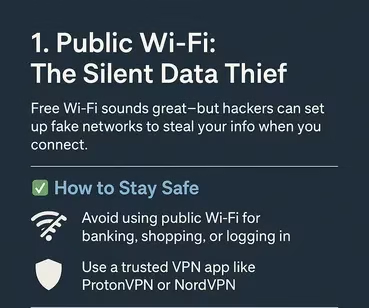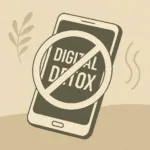“79% of detected cyber threats in 2025 are malware-free, making them harder to detect and emphasizing the need for behavior-based security measures. (CrowdStrike)”
You’re Being Watched—and You Don’t Even Know It
Every 39 seconds, someone gets hacked. Maybe your info isn’t out there yet, but that doesn’t mean it’s safe. In 2024 alone, cybercrime is expected to cost the world over $10.5 trillion. Your phone, your UPI, your social media—it’s all a goldmine for criminals.
One weak password, one app you forgot to update, or one click on a random link… that’s all it takes. Most of us don’t even realize how much of our personal data is floating around online. And by the time we do, it’s already too late. Your name, email, photos, even your bank details—gone in a blink, into the wrong hands.
This guide breaks down the common cyber threats you face every day and the simple, effective ways to protect yourself:
Table of content
- Phishing Scams – The Fake Message Trap
- Public Wi-Fi – The Silent Data Thief
- Weak Passwords – The Easy Entry
- Oversharing Online – The Hacker’s Info Mine
- Fake Apps & QR Codes – Trojan in Disguise
- Ignoring Updates – Open Door for Attack
- AI Deepfakes – The New Scam Frontier
- Final Checklist: Digital Defense Made Simple
- Final Words: Be Smart. Be Safe.
1. Phishing Scams – The Fake Message Trap
Continue reading ⤵
A message pops up:
“Your KYC is incomplete.”
“Your parcel is stuck. Click to reschedule.”
That click could give hackers access to your bank, your data—everything.
How to Stay Safe?
- ❗Never click links in suspicious SMS, WhatsApp, or emails.
- 🔍 Manually visit official websites instead (like your bank’s site or IRCTC).
- 📩 Use spam filters like Google’s Safe Browsing.
2. Public Wi-Fi – The Silent Data Thief

Free Wi-Fi sounds great—but hackers can set up fake networks to steal your info when you connect.
✅ How to Stay Safe
- 📶 Avoid using public Wi-Fi for banking, shopping, or logging in.
- 🛡️ Use a trusted VPN app like ProtonVPN or NordVPN.
What a VPN Does
- It encrypts your entire internet connection, even over public Wi-Fi.
- Hackers can’t see what you’re doing online, even if they’re on the same network.
- It creates a private tunnel between your device and the internet.
Think of it like sending your personal info inside a locked armoured truck instead of a postcard.
- ✈️ Or turn on Airplane Mode when not using your phone.
🛡️ Advice:
Public Wi-Fi + VPN = Safer, not foolproof.
If it’s an emergency or you absolutely must use it—VPN is your shield.
Otherwise, prefer using mobile data or wait till you’re on a trusted network.
3. Weak Passwords – The Easy Entry
“A password is like a toothbrush: choose a good one, don’t share it, and change it regularly.”
Using the same password everywhere—or easy ones like iloveyou, 123456, or your date of birth?
That’s like handing over your house key to strangers.
How to Stay Safe
📲 Enable Two-Factor Authentication (2FA) on all accounts. Learn how: Google 2FA guide.
🔐 Use unique, complex passwords for each login. Example: S@fe2025Bank!
📚 Use a password manager like Bitwarden (free and secure).
4. Oversharing Online – The Hacker’s Info Mine
✨ Bonus Tip:
Search for your name on Google or social media to see what’s publicly visible. You might be surprised how much is out there—and you can start cleaning up today.

Love posting pet names, birthdays, or vacation selfies? Hackers use this data to guess your passwords and security questions.
How to Stay Safe?
1. Make Your Social Media Accounts Private
- Set your Instagram, Facebook, and Twitter profiles to “private” so only friends/followers you approve can view your posts.
- On Facebook, check your privacy settings here to limit who sees your birthday, contact info, and posts.
- Avoid making entire photo albums public, especially those with kids or personal events.
2. Be Selective About What You Share
- Think of everything you post as a clue a hacker could use.
- Pet names? Often used in passwords.
- Birth dates? Great for password guesses or ID theft.
- Location tags? They know where you are and where you’re not (home!).
- 🔒 Better Rule: If you wouldn’t say it to a stranger in public, don’t post it online.
- 🤐 Don’t post sensitive info like IDs, travel plans, or address.
Be cautious of new friend requests—even if they have mutuals.
5. Fake Apps & QR Codes – Trojan in Disguise
A “loan approval” app or QR code on a flyer might not be real. Many spread spyware and ransomware.
How to Stay Safe?
- Use QR scanners with security features like Norton Mobile Security – Google Play and Apple App Store: Norton 360: Security & VPN
- Download only from official app stores (Play Store, App Store).
- Don’t scan QR codes from street signs, random websites, or shady messages.
6.Ignoring Updates – Open Door for Attack
Outdated apps or devices have holes that hackers love to exploit.
✅ How to Stay Safe
- 🔄 Always install updates for apps, browsers, antivirus, and your OS.
- ⚙️ Turn on auto-updates in phone/computer settings.
Don’t ignore that “Update Now” alert—it could save your identity.
7.AI Deepfakes – The New Scam Frontier
In 2025, hackers now use AI to clone voices and faces. You might get a call from someone who “sounds” like your boss or family member—asking for money or OTPs.
✅ How to Stay Safe
- 🤔 Always double-check before acting on urgent requests.
- 📞 Call back on the verified number—even if the voice seems familiar.
- 🔍 Learn more about spotting deepfakes at Deepware Scanner.
Final Checklist: Digital Defense Made Simple
- Think twice before clicking any link or scanning any code.
- Use a VPN when on public Wi-Fi.
- Don’t reuse passwords—use a manager.
- Lock your phone with biometric + PIN.
- Turn on 2FA for your accounts.
- Don’t overshare personal details.
- Keep everything updated—OS, apps, antivirus.
- Verify calls or messages that ask for urgent money or info.
Final Words: Be Smart. Be Safe.
In a world where almost everything we do touches the internet—from banking to bonding with loved ones, being digitally smart is no longer optional. It’s essential.
Hackers aren’t just going after only big companies anymore—they’re targeting everyday people like you and me. A careless click, an overshared post, or an unsecured Wi-Fi connection is all it takes to invite trouble.
But here’s the good news: you don’t need to be a tech expert to protect yourself. A few simple habits—like keeping your accounts private, using a VPN on public Wi-Fi, and being mindful of what you share—can go a long way in keeping your digital life secure.
So, pause before you post. Think before you click. Lock the digital doors just like you lock your home.
Stay aware. Stay protected. You’ve got this.
“Make your dear ones safe online! Share this article to spread the word“
Official Cybersecurity Guidelines
- Cyber Dost – Government of India Cyber Safety Tips
- CERT-In (Indian Computer Emergency Response Team)
- Stay Safe Online – National Cybersecurity Alliance (Global)
Check Suspicious Links & Websites
Tools to Stay Secure
- ProtonVPN – Free & Safe VPN
- Bitwarden – Free Password Manager
- Kaspersky QR Scanner App
- Have I Been Pwned – Check if your email was breached
Learn More About Cybersecurity
Track and Report Cybercrimes
Disclaimer:
This article is intended for general informational purposes only. The content reflects current best practices and publicly available resources related to cybersecurity. It does not constitute professional cybersecurity advice or guarantee absolute protection from online threats. Readers are encouraged to verify any tools or services before use and consult certified cybersecurity professionals for personalized guidance. The author and publisher are not liable for any loss or damage arising from the use of the information provided.




























Leave a Reply